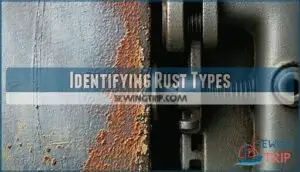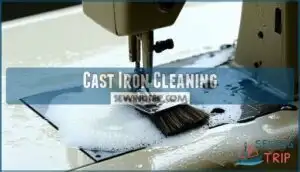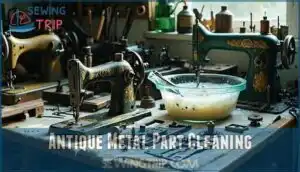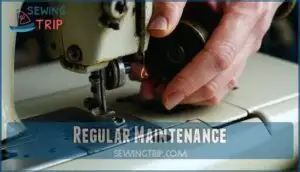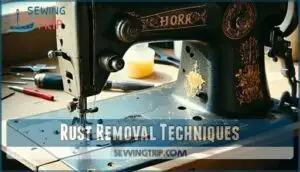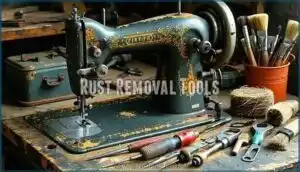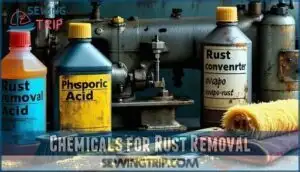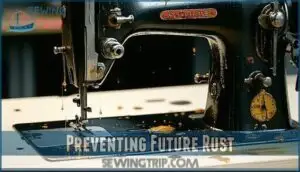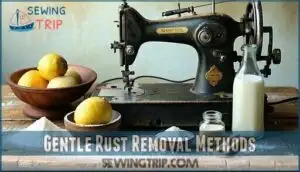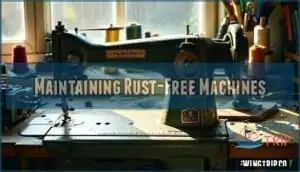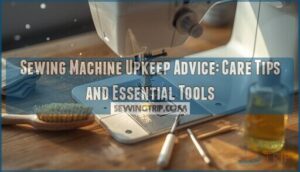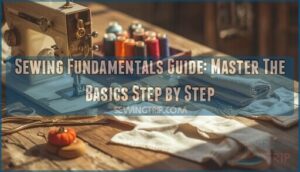This site is supported by our readers. We may earn a commission, at no cost to you, if you purchase through links.
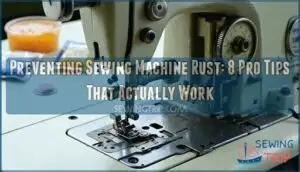
Store your machine in a dry, cool place away from basements or humid areas. Wipe it down after each use and oil moving parts regularly with quality sewing machine oil.
Keep silica gel packets nearby to absorb excess moisture. Never leave your machine near windows where condensation can form.
Clean dust buildup weekly since it traps moisture against metal surfaces. Cover your machine with breathable fabric, not plastic, which creates condensation.
A well-maintained machine lasts decades, but there are specific techniques that make all the difference, such as using quality sewing machine oil, keeping it in a dry, cool place, and using silica gel packets.
Table Of Contents
Key Takeaways
- Control moisture aggressively – Store your machine in a dry, cool place away from basements and humid areas, keep humidity below 45% with dehumidifiers, and place silica gel packets nearby to absorb excess moisture.
- Maintain regular cleaning and oiling – Wipe down your machine after each use, clean dust buildup weekly since it traps moisture against metal surfaces, and oil moving parts monthly with quality sewing machine oil.
- Use proper storage techniques – Cover your machine with breathable fabric instead of plastic to prevent condensation, never store it near windows where temperature changes create water droplets, and ensure good ventilation in your storage area.
- Act fast when rust appears – Identify whether you’re dealing with active rust (red-brown) or dormant rust (grayish), use gentle removal methods like vinegar soaks or baking soda paste, then apply protective coatings to prevent future oxidation.
Causes of Sewing Machine Rust
Your sewing machine develops rust when moisture combines with the iron in its metal parts, creating that familiar orange-brown coating.
Moisture + iron = rust’s perfect recipe for destroying your beloved sewing machine’s metal components.
The main culprits include humidity in your sewing room, lack of regular oiling, and storing your machine in damp areas like basements or garages, which can be considered a critical factor due to the presence of moisture.
Moisture Exposure
Moisture is rust’s best friend on your sewing machine. Water damage from spills consequences and fabric dampness creates the perfect storm for oxidation. Humidity exposure accelerates metal deterioration faster than you’d expect.
Here’s how moisture attacks your machine:
- Condensation Effects – Temperature changes create water droplets on metal surfaces
- Humidifiers Impact – Indoor humidity above 50% promotes rust formation
- Fabric Dampness – Wet projects transfer moisture to machine components
- Poor Humidity Control – Inconsistent moisture levels weaken protective coatings
Using a cover can also prevent sunlight damage.
Lack of Lubrication
Your machine’s moving parts need regular machine lubrication to prevent rust formation.
Without proper sewing machine oiling, metal components create friction that wears away protective coatings.
Focus on key lubrication points like the bobbin case and needle bar.
Different oil types serve specific purposes – lightweight lubricating oil works best for delicate mechanisms.
Follow your maintenance schedule religiously for maximum part protection and friction reduction.
Humid Environments
When humidity levels climb above 50%, your sewing machine becomes a rust magnet.
Coastal climates and tropical storage areas create perfect conditions for condensation risks and metal corrosion.
Install dehumidifiers in your sewing room to maintain moisture control below 45%.
A controlled storage environment prevents mold formation while protecting delicate mechanisms, which is crucial for proper moisture prevention that saves expensive restoration costs later.
Poor Maintenance
Neglect becomes your machine’s worst enemy when you skip regular cleaning and oiling.
Poor maintenance habits create the perfect storm for sewing machine rust to take hold and spread throughout your beloved equipment.
Five maintenance mistakes that guarantee rust problems:
- Skipping your monthly cleaning schedule – Dust and debris trap moisture against metal surfaces
- Ignoring lubrication requirements – Dry parts corrode faster without protective oil films
- Overlooking tension adjustments – Worn mechanisms stress metal components and accelerate damage
- Postponing minor repairs – Small issues become expensive restoration projects when left untreated
- Storing machines dirty – Residual lint and oils attract moisture and promote oxidation
Following a consistent maintenance schedule prevents costly repair bills while extending your machine’s lifespan substantially.
Identifying Rust Types
You can’t fix rust properly until you know what type you’re dealing with on your sewing machine.
Active rust appears red-brown and spreads quickly, while dormant rust looks grayish and stays in one place.
Active Rust
Red-brown active rust demands immediate treatment because it accelerates metal degradation at alarming speeds.
Act fast—active rust devours your sewing machine’s metal faster than you can say "stitch.
This aggressive corrosion type eats through your sewing machine’s components like acid, requiring urgent prevention measures.
Unlike dormant rust, active rust spreads rapidly when exposed to moisture.
You’ll need specialized rust inhibitors and active removal techniques to stop this destructive process before permanent damage occurs.
Dormant Rust
Gray-colored dormant rust sits quietly on your sewing machine’s surface, unlike its aggressive red cousin.
This stable form won’t spread aggressively but still needs attention.
Identifying dormant rust early helps you tackle it before it becomes problematic.
Here’s what makes dormant rust manageable:
- Light sanding removes it easily
- Gentle brushing clears most deposits
- No urgent chemical treatment needed
- Won’t eat through metal quickly
- Simple prevention stops its return
The key to managing dormant rust is to address it early and implement simple measures to prevent its return.
Rust Appearance
Spotting rust early saves your machine from serious damage.
Rust color tells the whole story – orange-brown patches signal active corrosion that’s eating away metal, while grayish areas indicate dormant rust that’s easier to handle.
Texture analysis reveals rough, flaky surfaces versus smooth discoloration.
Visual indicators help determine severity levels for proper treatment decisions, which is crucial for handling dormant rust.
Cleaning Sewing Machines
You’ll prevent rust formation by establishing a regular cleaning routine that removes dust, dirt, and moisture from your sewing machine’s metal surfaces.
Clean your machine after each use with a soft cloth, and perform thorough cleaning sessions monthly to maintain all components in rust-free condition, which helps in preventing rust formation.
Cast Iron Cleaning
Cast iron components need gentle care to avoid damage.
Start with soap selection – use mild dish soap mixed with warm water. Choose soft brush types like nylon bristles to prevent scratching the surface.
Apply proper rinsing methods with clean water to remove all soap residue.
Master drying techniques by patting dry immediately, protecting the finish from moisture that leads to rust formation.
Antique Metal Part Cleaning
When you’re dealing with antique metal parts, you’ll want to tackle them differently than cast iron surfaces.
These delicate pieces need extra care during rust removal and antique restoration.
Here’s your game plan for cleaning antique metal parts:
- Part Disassembly – Remove loose screws and bolts before starting any rust cleaning techniques
- Overnight Soaking – Submerge parts in warm water with dish soap for thorough penetration
- Hot Water Rinse – Use hot water to remove stubborn dirt and cleaning residue completely
- Soft Cloth Drying – Pat dry with paper towels, then finish with clean cloth for metal restoration
To protect these parts after cleaning, consider using sewing machine oil.
Regular Maintenance
Consistent machine maintenance beats reactive repairs every time.
Check your needle condition monthly and inspect moving parts for wear signs. Remove thread residue and lint buildup after each project to prevent moisture trapping.
Establish an oiling frequency schedule based on usage patterns. Apply rust inhibitors to vulnerable areas during routine sewing machine care sessions for effective preventing corrosion, which is a key part of machine maintenance.
Removing Rust From Machines
When rust appears on your sewing machine, you’ll need to choose the right removal method based on whether it’s active red-brown rust or dormant grayish rust.
You can use chemical rust removers for stubborn active rust or simple tools like steel wool and sandpaper for lighter dormant rust buildup.
Rust Removal Techniques
You’ll encounter several rust removal techniques when tackling corroded sewing machines.
Chemical conversion transforms rust into protective coatings using phosphoric acid solutions. Electrolysis method uses electrical current for precise removal. Ultrasonic cleaning reaches intricate parts effectively. Laser ablation offers non-contact precision for delicate components.
Abrasive blasting works well for heavy rust situations. Wire brushes are effective for surface rust removal.
Choose methods based on your machine’s condition and value.
Rust Removal Tools
Professional rust removal tools make the difference between frustration and success.
Wire brushes with soft nylon bristles scrub away stubborn oxidation without scratching delicate surfaces. Dremel attachments reach tight spaces on ornate faceplates and intricate components.
Rust erasers gently polish away surface corrosion. For heavy-duty projects, ultrasonic cleaners penetrate every crevice.
These metal cleaning tools transform your restoration process completely. Many machines have cast iron frames that are especially prone to rust.
Chemicals for Rust Removal
Commercial rust removal chemicals pack serious punch when gentle methods fail.
Evapo-Rust details show it’s safe for overnight soaking without damaging metal. Acid-based removers like phosphoric acid dissolve stubborn oxidation quickly.
Alkaline solutions neutralize rust while converter effectiveness creates protective barriers. Solvent applications work fast on surface rust.
Choose rust cleaning products based on your machine’s specific corrosion level. For chrome parts, consider using Simichrome for polishing.
Preventing Future Rust
You’ve cleaned your sewing machine and removed existing rust, but now you need to create a protective barrier against future oxidation.
Applying rust inhibitors, lubricating oils, or rust-preventing wax forms a shield that blocks moisture from reaching metal surfaces and stops new rust from forming.
Rust Inhibitors
Rust inhibitors create protective barriers that block moisture from reaching metal surfaces.
You’ll find organic and inorganic coating types available for sewing machine rust prevention. Apply these compounds to clean, dry metal parts for maximum inhibitor effectiveness.
Commercial rust inhibitors offer superior long-term protection compared to DIY inhibitors. Consider purchasing a rust inhibitor for ideal results.
Choose inhibitor application methods based on your machine’s specific needs and environmental conditions, using the right rust inhibitor for ideal results.
Lubricating Oil
Proper lubrication keeps your machine’s metal parts protected from moisture and oxidation.
Sewing machine oil creates a barrier that prevents rust formation on moving components.
Apply lightweight machine oil to pivot points, gears, and shafts monthly.
Synthetic oils last longer than petroleum-based options.
Consider using specialized machine lubricants for superior performance.
Check your manual for specific lubrication frequency recommendations and use only designated sewing machine oils for optimal protection.
Rust-Preventing Wax
Wax application creates a protective barrier that’s tougher than oil alone.
Apply rust-preventing wax to clean, dry surfaces using circular motions. Carnauba and synthetic wax types offer long-term protection against moisture.
Surface preparation matters—remove all dirt first. These rust prevention products last months longer than alternatives.
Reapply wax every six months for maximum rust prevention effectiveness.
Storage and Environmental Control
Where you store your sewing machine matters more than you might think regarding preventing rust.
You’ll need to control both temperature and humidity in your storage area to keep moisture away from metal parts that can corrode over time.
Dry Storage
Store your sewing machine in airtight containers with protective covers to block moisture completely.
Choose storage locations away from basements and garages where humidity lurks.
Dehumidifiers work wonders in damp rooms, while desiccant packets inside containers provide extra moisture protection.
Monitor humidity levels regularly – dry storage remains your strongest defense against rust formation on precious machine components.
Temperature Control
Consistent temperatures between 60-75°F create the ideal temperature for your sewing machine’s long-term health.
Temperature fluctuation causes material expansion and contraction, leading to component sensitivity issues that invite rust formation.
Dramatic swings create condensation prevention challenges, as warm air holds more moisture than cold air.
Maintain steady conditions to protect delicate metal parts from destructive temperature-related damage, and to ensure the overall health of your sewing machine by preventing condensation.
Humidity Control
Humidity levels above 60% spell trouble for your sewing machine’s metal parts.
You’ll want to keep ideal humidity between 40-45% using dehumidifiers for effective moisture protection.
A hygrometer helps with climate monitoring, while proper ventilation strategies prevent poor ventilation issues.
This combination delivers superior rust prevention compared to relying on temperature control alone.
Silica Gel Packets
Place silica gel packets strategically around your sewing machine storage area for effective moisture protection.
Their effectiveness depends on proper packet placement near vulnerable metal components.
You can reactivate packets by heating them in a low oven for extended packet longevity.
Alternative desiccants like activated charcoal work too, though silica remains superior for rust prevention and machine storage needs.
Maintaining proper humidity control is also essential to prevent rust.
Gentle Rust Removal Methods
When rust appears on your sewing machine, you don’t need harsh chemicals to remove it effectively.
Simple household items like vinegar, baking soda, and lemon juice can safely remove rust without damaging delicate metal parts.
Vinegar Soak
White vinegar’s acetic acid dissolves rust through direct contact with iron oxide.
Create a vinegar dilution using equal parts water and vinegar for gentle treatment.
Soak duration should range from several hours to overnight, depending on rust severity.
Verify metal compatibility before application, as some finishes may react poorly.
Apply thorough post-soak treatment with clean water rinsing and complete drying.
Baking Soda Paste
Baking soda paste offers gentle rust prevention methods for your machine.
Mix three parts baking soda with one part water for ideal mixing ratios. This rust prevention technique provides mild abrasive qualities without damaging surfaces.
Paste application benefits:
- Surface compatibility with vintage metals
- Effective stain removal without scratching
- Safe sewing machine rust prevention solution
Lemon and Salt Scrub
The lemon and salt scrub combines natural lemon acidity with salt abrasiveness to create an effective rust removal paste.
Mix equal parts lemon juice and salt until you achieve proper paste consistency. Apply using gentle circular motions, verifying material compatibility with your sewing machine’s metal surfaces.
| Component | Purpose |
|---|---|
| Lemon Juice | Provides natural acidity to dissolve rust |
| Salt | Creates abrasive action for scrubbing |
| Paste Form | Ensures controlled application technique |
| Gentle Motion | Prevents surface damage during cleaning |
The combination of lemon juice and salt creates a paste that is both effective and easy to apply, making it a great solution for removing rust from metal surfaces.
Citric Acid
Citric acid solution offers a gentler alternative for rust removal methods on delicate sewing machine components.
Mix one tablespoon of citric acid powder with one cup of warm water for ideal citric acid concentration. This rust removal technique breaks down oxidation without harsh abrasives.
Apply using soft cloths, ensuring complete residue removal afterward. Always wear gloves as safety precautions when handling acidic solutions, to prevent any potential harm, emphasizing the importance of safety precautions.
Maintaining Rust-Free Machines
You can keep your sewing machine rust-free by checking it regularly and applying protective coatings to metal parts.
Store your machine in a well-ventilated area and keep it away from water to prevent moisture damage.
Regular Inspection
Smart sewing machine maintenance starts with catching problems before they snowball. Your machine’s metal components need regular checkups to stay rust-free and functional.
- Early rust signs detection – Examine needle plates, tension discs, and bobbin cases monthly for orange-brown discoloration or surface pitting that signals oxidation beginning.
- Component vulnerability check – Focus on areas where moisture collects like thread paths, lubrication points, and joints between different metal parts.
- Thread path inspection – Check guides, tension mechanisms, and feed dogs for wear patterns or corrosion that could affect stitch quality and machine performance.
Protective Coatings
Once you’ve spotted trouble areas, protective coatings become your machine’s armor against rust.
Surface preparation matters most – clean metal accepts coatings better.
Rust inhibitors, specialized waxes, and metal preservation sprays offer different coating types for various needs.
Coating application requires thin, even layers for coating durability.
These rust protection methods provide long-term protection when applied correctly, making corrosion protection simple yet effective.
Avoiding Water Contact
Water is rust’s best friend, so keep your sewing machine far from liquid spills and accidents.
Spill Prevention starts with clearing beverages from your workspace. If accidents happen, take Immediate Action – unplug the machine and dry all surfaces thoroughly.
Never use Wet Cloths for cleaning; they introduce moisture that causes corrosion. Always dry components completely after any water contact to prevent rust from forming, which is why Spill Prevention is crucial.
Well-Ventilated Storage
Proper airflow keeps moisture from settling on your machine’s metal components.
Good ventilation methods create an environment where rust can’t take hold, extending your sewing machine longevity substantially.
Choose storage locations with these ventilation essentials:
- Open spaces away from corners and walls
- Rooms with natural air circulation
- Areas where dehumidifier use complements airflow
- Breathable cover materials that allow air movement
Frequently Asked Questions (FAQs)
How do you remove rust from a Vintage sewing machine?
Like treasure hunters restoring ancient coins, you’ll identify rust type first.
Use gentle methods like vinegar soaks for light rust, or Dremel tools for stubborn spots.
Always dry completely and apply protective oil afterward.
Can a rusty sewing machine be salvaged?
Yes, you can salvage most rusty sewing machines with patience and proper techniques.
Active rust requires chemical removers, while dormant rust responds to gentle scrubbing.
Success depends on rust severity and component condition.
Do vintage sewing machines rust?
Vintage vixens absolutely attract rust.
Your beloved antique machine’s metal components become magnets for moisture over time.
Without proper care, humidity and age conspire against these treasures, making rust prevention essential for preserving their mechanical magic, especially since these components are prone to attract rust.
How to clean a rusty sewing machine?
Start by identifying rust types – active rust appears red-brown while dormant rust looks grayish.
Use gentle methods like vinegar soaks, baking soda paste, or commercial rust removers, then apply protective coatings.
Why does a sewing machine rust?
Your sewing machine rusts when iron parts meet oxygen and moisture, creating ferric oxide.
This magnetic compound attracts more water, speeding up corrosion.
Poor lubrication and humid storage make rust spread faster.
How do you remove rust from a vintage Singer sewing machine?
First, identify whether you’re dealing with active rust (red-brown) or dormant rust (grayish).
Use gentle methods like vinegar soaks, baking soda paste, or citric acid solutions before trying abrasive tools like Dremel attachments.
Does sewing machine oil prevent rust?
Like armor protecting a knight, sewing machine oil creates a protective barrier on metal surfaces.
You’ll prevent rust by regularly oiling your machine since the lubricant displaces moisture and shields components from oxidation.
How to get rid of rust on a sewing machine?
Remove rust by identifying its type first.
Use gentle methods like vinegar soaks or baking soda paste for light rust.
For stubborn rust, apply commercial rust removers or use fine steel wool carefully to avoid damaging delicate parts, utilizing methods that are often considered stubborn.
Can I use WD40 on my sewing machine?
WD-40 isn’t ideal for your sewing machine’s delicate internal parts.
It’s too heavy and attracts dust.
Instead, use proper sewing machine oil for moving parts and light rust prevention on external metal surfaces only.
How does vinegar prevent rust?
Think of vinegar as a gentle warrior against rust’s advance.
You’re creating an acidic environment that dissolves iron oxide formations.
Vinegar’s acetic acid breaks down rust particles, but it won’t prevent future oxidation without protective coatings.
Conclusion
Like a well-tended garden that flourishes with consistent care, preventing sewing machine rust requires daily attention to moisture control and maintenance habits.
You’ve learned eight proven strategies that protect your investment from corrosion damage.
Remember to store your machine in dry conditions, oil moving parts regularly, and use silica gel packets for moisture absorption.
Clean dust buildup weekly and cover with breathable fabric.
These simple steps guarantee your sewing machine remains rust-free for decades of reliable service, ensuring it provides reliable service.
- https://www.eharrisgallery.com/clean-vintage-sewing-machine/
- https://leatherworker.net/forum/topic/67710-remove-old-oil-and-rust-without-removing-the-paint-any-ideas/
- https://sewing.patternreview.com/SewingDiscussions/topic/54235
- https://www.sciencedirect.com/science/article/pii/S2666845924000783
- https://link.springer.com/article/10.1007/s11998-021-00547-0

